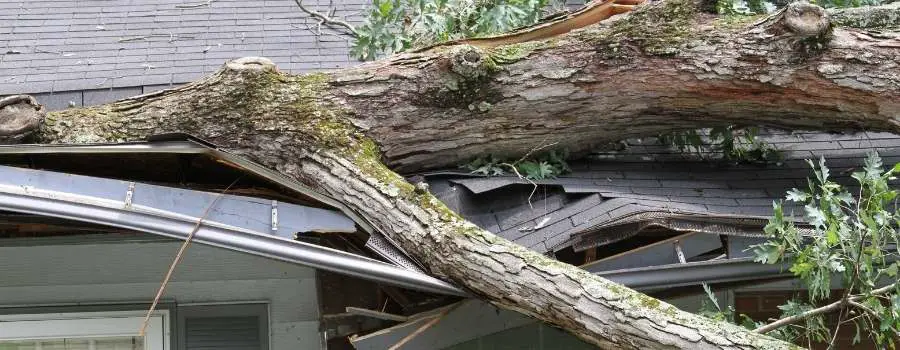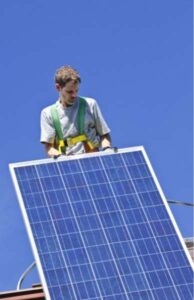
Winter, Spring, Summer, or Fall…there’s always seems to be something flying around that can fly into and possibly damage your solar panels.
A solar panel is made up of many individual cells, and one or more can be damaged if the panel takes a direct hit. A single cell may not seem like much, but when you multiply that by how many panels are on your roof, suddenly those dents in some panels become quite significant.
The good news is that while solar panel cells are not designed to withstand heavy impacts, they’re also able to take quite a bit of abuse and can be very durable if you care for them properly.
What Types Of Objects Can Hit And Possibly Damage My Solar Panels?
Solar panels are commonly damaged by natural objects like tree branches, hail, or branches. Other objects can be baseballs, golf balls, frisbees, kites, and other sports equipment and toys. Even animals such as squirrels and birds can cause damage to your panels.
When people consider what types of projectiles can strike and possibly cause damage to their solar panels, the usual things that come to mind are tree branches. This makes sense because people often have homes built into the tree line and over the years branches can start to drape over your roof.
But there are other things that might be unique to you and where you live, so what else should you be on the lookout for?
- Tree Nuts and Pinecones – Not likely to cause damage other than building up on top of the panels and blocking out sunlight.
- Limbs and Twigs Being Blow By High Winds – This could lead to scratches or get lodged under the wracking, but most small limbs won’t harm your panels. Of course, if the winds are strong enough, even a small twig hitting at the right angle could cause some micro cracks.
- Hail – This is one to be concerned with. Normal, pea-sized hail shouldn’t be a problem, but larger hail could start to be a problem.
- Animals – More likely to be a nuisance than cause any damage. Nesting critters could fling debris over the surface of your panels, lowering the amount of sun that reaches them.
- Baseballs – A baseball is definitely hard enough to start damaging your solar panels. Panels are designed to not shatter, but a baseball could cause some significant micro cracks.
- Golf Balls – This is more common than baseball since so many people live on golf courses and we triple-digit scorers are known to hit an errant shot or two. Players can send a golf ball flying at 180 mph+ if they can crack…and sometimes embed…in a car’s windshield, they can definitely do the same to a solar panel.
- Frisbees – A frisbee might scratch the surface of a solar panel as it skitters across but isn’t likely to do any significant damage. Just don’t let a dozen frisbees get stuck on top of your panel array.
- Kites – Other than blocking out sun rays a kit shouldn’t damage a solar panel.
Luckily, solar panels are designed to withstand all of these as far as impacts are concerned. If mother nature decides to fling hail that is larger than a golf ball at you then you probably have more pressing concerns.
When it comes to animals you shouldn’t be too concerned about them running across them…they likely won’t since they are slippery and usually very hot…or from them breaking them.
Your main problem here would be nesting critters like birds, squirrels, or worst of all, bees and wasps. Wires can be chewed on or tugged on, scratches and debris can start to block the solar cells, and anything that can sting you should probably be moved away from your house.
Manufacturers of solar panels know that they are going to be outside and have to withstand the elements, so they are designed for that. Solar panels rarely shatter or break in half from normal surroundings or the elements.
The vast majority of solar panel manufacturers have designed their panels to withstand impacts equal to golf ball-sized hail and withstand winds up to 140mph.
Of course, anything can happen and a rogue tree limb can come hurling towards your solar panels and hit them at just the right spot and at the right angle and destroy the panel…but this is very rare.
More often than not, solar panels will start to lose their efficiency and show signs of “damage” from micro-cracks.
How Do Solar Panels Get Micro-Cracks?
Micro-cracks occur to solar panels due to being hit, bent, or from snow sliding off. Micro-fractures won’t destroy your solar panels, but as you get more of them you’ll start to lose efficiency.
The main issue is that these micro-cracks cause some cells to lose efficiency, and over time more cells will start to crack until eventually, the panel becomes completely non-functional.
For instance, if a single cell has 20% efficiency then two cracked cells might be around 15% efficiency, three cracked cells would be 12.50%, and so on.
The good news about micro-cracks? They can be fixed!
How Do You Fix Micro-Cracks On Solar Panels?
Typically, if you have a single cell that is cracked the crack can be fixed by filling it with silicone. If more than one cell has been damaged and they are overlapping then you’ll need to replace them entirely.

The cost of repairing or replacing solar panels will depend on how many cells were present in the panel before being broken.
In general, a single cell can be repaired for under $50, and if it needs to be replaced then you might pay up to $300.
If more than one cell has been damaged in your solar panel system the cost is going to increase exponentially. The reason being that when replacing panels they need to match not only the same number of cells but also the voltage.
If you have a solar panel system with more than 12 cells and they are all damaged then the entire system needs to be replaced entirely, meaning that you would end up paying upwards of $3000 for just replacing the panels themselves.
The cost increases when adding in installation costs because it’s labor-intensive…especially if your old panels were installed in a place that is difficult to get to.
How Do I Protect My Solar Panels From Impacts?
- Ask your solar installer to install a secondary impact-resistant system. This is not necessary on every installation, but it may be worth considering if you have lots of trees or other obstacles that could potentially damage the panels.
- Similar to a dedicated secondary impact-resistant system, some people opt to fabricate a protective layer themselves using plexiglass or tempered glass. These two options offer protection but also come with their own negatives that I’ve outlined in this article.
- Make sure that any debris around the site where your solar power system was installed has been cleared away so there’s no chance of anything getting thrown up into the panels.
- Clean your solar panels often to protect them from damage. Dirt can wear away at the surface layers that prevent impacts and scratches which is why it’s so important to clean as often as possible.
- If you live in an area where hailstorms are a risk, you may want to consider adding hail guards. Hail panels can be retrofitted onto the existing array to protect against this type of weather event.
- Be sure that you have some form of insurance or extended warranty on your solar power system so that any damage is covered in the event that it does happen.
What Is A Secondary Impact-Resistant System?
A secondary impact-resistant system is a system that can be installed on solar panels to help protect them from impacts. This would not necessarily need to be added to every installation but may make sense for installations in areas with trees or other obstacles where the risk of being impacted could potentially cause significant damage.
The secondary panel is made up of two layers. The top layer is made out of acrylic, and it’s designed to bounce or deflect an object back up. The bottom layer is made from glass which will help protect against any other impacts that could cause property damage. It does this by slowing down the impact so they’re not as strong.
The installation cost of these panels is higher than standard panels and will need to be paid for at the time of purchase or financing agreement as well as any additional costs associated with installing them.
It’s worth the extra investment though if you live in an area where there are potential risk factors for your solar system.
Final Thoughts
Solar panels can take a hit…that’s for sure, but there are always exceptions. Unless you live on a golf course with a lot of below-average players you shouldn’t worry too much about heavy damage to your solar array.
If you live in an area where there is the risk of hail or other types of weather that could affect your system, it may be worth adding some form of protection to help keep them safe and sound.
Most homeowners insurance policies will cover solar panels and some insurance companies offer additional coverage…but always check with your insurance provider to see what they’ll cover so you’re not caught off guard in the future.

